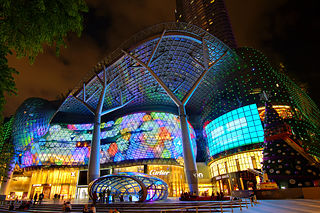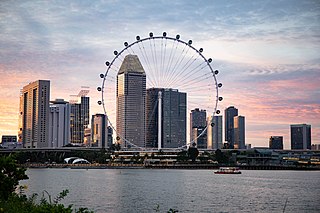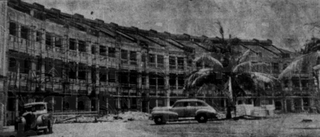
Orchard Road, often known colloquially as simply Orchard, is a major 2.5 km (1.6 mi)-long road in the Central Area of Singapore. A famous tourist attraction, it is an upscale shopping area, with numerous internationally renowned department stores, shopping malls, restaurants, and coffeehouses located in its vicinity. It's a popular hotspot in Singapore, especially at night, attracting trendy urban youth.

Ngee Ann City is a shopping and commercial centre located on Orchard Road, Singapore. The S$520 million building was officially opened on 21 September 1993 by then-Prime Minister Goh Chok Tong.

Lau Pa Sat, also known as Telok Ayer Market, is a historic building located within the Downtown Core in the Central Area of Singapore. It was first built in 1824 as a fish market on the waterfront serving the people of early colonial Singapore and rebuilt in 1838. It was then relocated and rebuilt at the present location in 1894. It is currently a food court with stalls selling a variety of local cuisine.

This article shows the notable future developments in Singapore. Most of them are currently under construction with most to be completed within the next five years.

The Specialists' Shopping Centre was the oldest shopping centre on Orchard Road, a shopping area of Singapore. The largest tenants were Hotel Phoenix Singapore and John Little. The Visitor's Guide of Singapore described it as "revered". It was demolished to make way for newer developments in 2008.

The Old National Library Building was a historical library building at Stamford Road in the Museum Planning Area of Singapore. Originally completed in 1960, the library building was a national icon for many Singaporeans. Despite a huge groundswell of public dissent, the library was closed on 31 March 2004, and was demolished in July that year to make way for the construction of the Fort Canning Tunnel to ease road traffic to the city. The controversy surrounding the building's demise has been credited for sparking greater awareness of local cultural roots and an unprecedented wave in favour of heritage conservation among Singaporeans.

The Singapore Badminton Stadium, formerly Singapore Badminton Hall, is a indoor sports hall for badminton located on Guillemard Road in Geylang, Singapore.

The Fullerton Hotel Singapore is a five-star luxury hotel located near the mouth of the Singapore River, in the Downtown Core of the Central Area, Singapore. It was originally known as the Fullerton Building, and also as the General Post Office Building. The address is 1 Fullerton Square. The Fullerton Building was named after Robert Fullerton, the first Governor of the Straits Settlements (1826–1829). Commissioned in 1924 as part of the British colony's centennial celebrations, the building was designed as an office building by Major P.H. Keys of Keys & Dowdeswell, a Shanghai firm of architects, which won the project through an architectural design competition. The architectural firm also designed the Capitol Theatre, its adjoined Capitol Building and the Singapore General Hospital. In 2015, it was designated as a national monument of Singapore.
Swan & Maclaren Group business have expanded beyond Architecture & Urban Design, and presently include Interior Design, Adaptive Reuse, Illumination Engineering, Immersive Experience Design, Sustainability Solutions, and in the near future, Luxury Senior Living development. One of the oldest architectural firms in the country, it was formerly known as Swan & Maclaren and Swan & Lermit, and was one of the most prominent architectural firms in Singapore when it was a crown colony during the early 20th century. The firm has designed numerous iconic heritage buildings in Singapore as well as Malaysia. Presently headquartered in UE Square Singapore, the firm has continued to design numerous projects in contemporary Singapore. Swan & Maclaren Group has operational presence in several countries around Asia, UK and the Middle East.

Stamford House is a historic building located at the corner of the junction of Stamford Road and Hill Street, in the Downtown Core of Singapore. Originally known as Oranje Building, it formerly housed a shopping mall. The building had since redeveloped along with adjoined Capitol Building and both were reopened as a hotel The Capitol Kempinski Hotel Singapore in October 2018.

The Bank of China Building is a development consisting of two skyscrapers located in the central business district of Singapore. It is located on 4 Battery Road, adjacent to 6 Battery Road, Maybank Tower, and roughly 100 metres from the Fullerton Hotel. The Tower serves as the headquarters for the Bank of China.

Orchard Point is a shopping centre in Singapore.

Tanglin Halt is a public housing estate, planning subzone and former industrial estate in Queenstown, Singapore. Most of the older buildings in the estate are set to be demolished by 2024 to make way for redevelopments under the Selective En bloc Redevelopment Scheme. It is the third housing estate to be redeveloped under the scheme.
Amber Mansions was a shopping centre and residential building located at the curve between Orchard Road and Penang Road in what is currently known as Dhoby Ghaut, Singapore. Constructed in the 1920s, the shopping centre was one of the first shopping centres in Singapore.

Malayan Bank Chambers, also known as Maybank Chambers and originally known as the Whiteaway Laidlaw Building or the Whiteaway Laidlaw & Co Building, was a building on Battery Road in Singapore.
The Heeren Building was a building built on the corner of Orchard Road and Cairnhill Road in Singapore in 1931. It was demolished in 1990 due to a road realignment project.

Teochew Building is a historic building on Tank Road in Singapore. Completed in 1963, it jointly houses the Teochew Poit Ip Huay Kuan and the Ngee Ann Kongsi.
Wisma Indonesia was a building on Orchard Road in the Orchard Planning Area of Singapore. Completed in 1964, it was constructed to house the Embassy of Indonesia in Singapore, which was only able to move into the building in 1967 as a result of Konfrontasi. It was demolished in 1983 to make way for the Wisma Atria after the embassy moved to Chatsworth Road.

The Criminal Investigation Department Headquarters, initially known as New Detective Station, was a building at the junction of Robinson Road and Cecil Street in the Central Area of Singapore. Completed in 1931, it housed the Singapore Detective Branch, later renamed the Criminal Investigation Department. In 1940, the Special Branch, which later became the Internal Security Department, moved into the building, where it remained until 1976. The Criminal Investigation Department moved elsewhere in 1993, while the building was demolished in 1995 to make way for the Capital Tower.

Crescent Flats, also known as The Crescent, was an apartment building on Meyer Road in Katong, Singapore. Completed in 1912, it is believed to have been the first apartment building built in Singapore. Designed by Regent Alfred John Bidwell for Manasseh Meyer, both the building and the neighbouring Meyer Flats, built as a companion block, were demolished to make way for a condominium project.

















